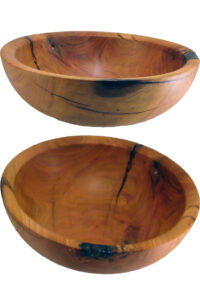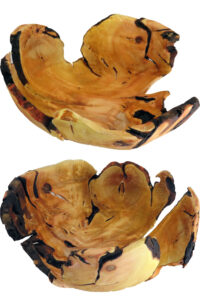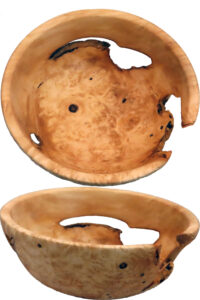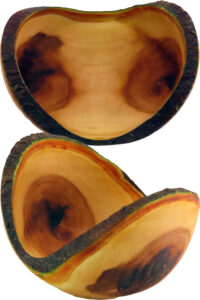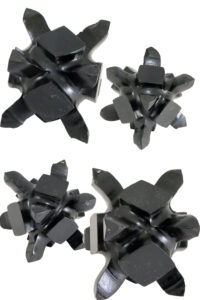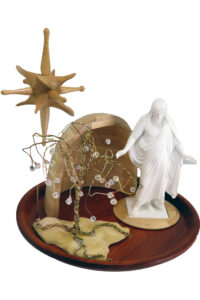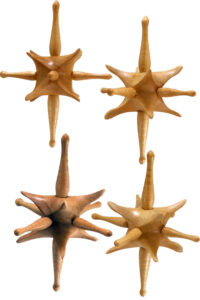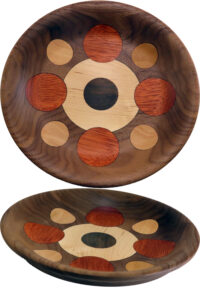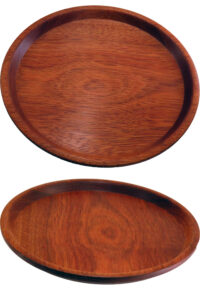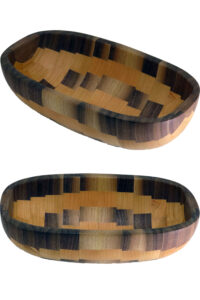Peach Bowl To Preserve Precious Memories
This is not the best example of wood for bowl turning. However, it was essential to turn this bowl anyway as a return gift to the lady in whose yard this tree grew. I filled the major cracks with ultra violet activated resin which I am finding very convenient for small repairs. It is supposed to be longer lasting than CA glue.
The completed bowl will be returned to the lady to preserve her memories associated with her family and this peach tree.
The bowl is nine inches diameter and three inches high, finished with wipe-only poly.
Enjoy.
Rose Bowl From The Root
This video post is best viewed here on this page. However, if you have technical difficulties, it is also posted on YouTube and FaceBook.
After digging up an old rose bush from my yard, I attempt to turn the root ball to get a bowl.
At 8″ by 3″, this bowl warped dramatically making it too warped to finish turning and sanding it on the lathe. Still, I carved and sanded it before finishing with walnut oil.
It is unique.
Enjoy.
Rejected, Discarded But Beautiful Burl Bowl
This video is best viewed right here on this page. However, if you are experiencing technical difficulties, it is also posted on YouTube and FaceBook. Please return here.
This cottonwood was discarded at our club’s monthly Saturday gathering. Why discarded? The piece had a pair of smaller burl bumps. One had an accidental gash from a chain saw; the other had large obvious voids.
I picked it up anyway and decided to see if I could get anything from it. It yielded a 6″ diameter, 2″ tall bowl with amazing burl figure. Walnut oil brings out the beautiful color.
Enjoy.
Turning – My Quest For A Wood Star
Please view this video here. However, if there are difficulties, it is also posted on YouTube and FaceBook.
After turning an eight point star inspired a few weeks ago, I had a another thought about how to turn a star yet another way. I was not sure it could be successful. However, I decided to try.
Previously I have:
- Turned a sphere and added finials;
- Turned a cube into a star using a specific, custom jig;
- Turned a cube into a star using a pen mandrel centered on faces, then adding finials;
- Turned a cube into a star using a pen mandrel centered on faces but with much deeper coves, then adding finials;
- And now, turn a cube into a star using the corners of the cube. Could I add finials???
I am now wondering where else my star quest can go.
Here are the previous videos
Turning Multi Axis Eight Point Star With Jig
Turning 8 Point 3 Axis Star Ornament – No Jig Required
Turning 8 Point 3 Axis Star – Best Yet
Link to Drive Centers
https://www.printables.com/model/824088-drive-centers-or-hubs-for-woodturning-8-point-star
What do you think about the differences in the process? Which do you prefer?
Enjoy.
Turning Finishing Touches To My Easter Diorama
This video is best viewed here on this page. If you are having technical difficulties, please try YouTube or FaceBook.
This project is the culmination of several projects. It is a diorama with a theme of Jesus Christ’s resurrection. It consists of a tray, a star, a tomb, a wire tree, and a miniature statue of Jesus Christ.
This video details the tomb, a segmented project with eight segment rings with segment counts from six to twenty segments. The variance in segments enables aligning joints at each half ring. Then by aligning this joint from ring to ring, it can be sawn in half and have a full segment on each half bowl. Recently, for an oval bowl, the half bowls were glued together to form an oval bowl. The tomb represents the empty tomb after the resurrection. The wood is maple. This is an evolution of previous video titled “Turning Oval Bowl With Basic Tools – Segmented (Or Solid)“
The miniature statue of Jesus Christ is a replica of the Christus by Danish sculpturor, Bertel Thorvaldsen. This is available at Amazon and other stores.
The wire tree consists of 27 strands of 22 gauge brass wire with five different finishes. The wire is wrapped together to form the tree and root system. As the limbs branch out, the wire count is reduced. At the end of each wire, a clear bead is attached. The tree is mounted to a piece of carved wood for stability. Wire from Amazon
The tray is bloodwood as shown in the project titled “Turning My Tray (Not A Platter??)“. The choice of bloodwood was appropriate since Jesus Christ’s blood was shed for us.
The star is maple as shown in the project titled “Turning 8 Point 3 Axis Star – Best Yet“. The star represents the celestial star which signaled His birth.
The complete diorama will be displayed in an Easter exhibit.
Enjoy.
Turning 8 Point 3 Axis Star – Best Yet
This video post is best viewed here on this page. However, in case of technical difficulty, it is also available on YouTube and FaceBook.
A few weeks ago, I turned an eight point star inspired by an ornament submitted in last year’s Ornament Challenge. From comments, I learned that I did not turn it exactly as they had but close enough.
However, I wanted a star with more pointed rays. So, I am taking the concept a bit further by cutting a deeper cove at each mount. I wanted to see if this would work also.
Did it work?
Here are the previous videos:
- Turning Multi Axis Eight Point Star With Jig
- Turning 8 Point 3 Axis Star Ornament – No Jig Required
What do you think about the differences in the process? Which do you prefer?
Enjoy!
Turning An Inlay Tray Or Platter – Better Yet!
This video is best viewed here on this page. But, if you are having problems, it is also post on YouTube and FaceBook.
After returning from the Rocky Mountain Woodturning Symposium, I turned a inlaid platter or tray, using the lathe for drilling. This was a test. At the symposium, the presenter had used a vacuum chuck to hold the project while drilling on the lathe. But, at that time, I had a thought “why use the lathe – can’t the drill press do as well with less hassle?”. In addition, I wanted to have the inlay show as part of a curve in the profile.
This design is inspired by a compass pattern. The background is walnut. Inlay pieces are maple, bloodwood, and sycamore. The back is maple veneer and walnut. The 7″ platter is finished with wipe-on poly.
A drill press was used for all drilling operations instead of the lathe.
Here’s the previous video using the lathe for drilling. Here’s the link. Turning An Inlay Tray or Platter Without Vacuum Chuck
What do you think about the differences in the process? How would you do this inlay?
Enjoy.
Turning My Tray (Not A Platter??)
This video post is best viewed here on this page. If there are technical difficulties, it is also posted on YouTube and FaceBook.
I need a smaller tray for an upcoming project (Patience please).
Our club had a demonstration for a platter. To me, trays and platters are similar except for a broader base and a flat interior.
The wood is bloodwood 9 inches in diameter, finished with wipe on poly.
Back to the tray. With only one inch thick wood, there is no room for a screw chuck. Instead, I use a threaded wood faceplate with double stick tape reinforced with hot melt glue.
Enjoy.
Turning Oval Bowl With Basic Tools – Segmented (Or Solid)
This video post is best viewed here on this page. However, in case of gremlin attach, it is also posted on YouTube and FaceBook.
Why purchase an expensive oval jig to turn an oval bowl? When, with a little planning, I can turn it.
Where is the difficulty? Actually, the final oval-ness is easy – simply(?) cut a bowl in half, then glue the rims of the two half bowls together.
To be honest, IMHO, not every bowl is suitable for this minor surgery. I had to ponder the appropriate shape.
Finally, the joint does take some sanding. However, a good flat rim that flairs slightly inward and outward reduces the sanding requirement.
As for being a segmented bowl, I did not want segments cut in half or less. I wanted a full segment at the cut line. Then, how do I overlap segment joints and still have a full segment at the cut line?
In the end, the segment rings vary in segment numbers from 6 segments per ring to 20 segments per ring for a total of 104 segments. No joints correspond from ring top ring. The 6 by 9 inch bowl is 3 inches tall and is finished with wipe-on poly. A small flat on the bottom serves to stabilize the bowl from rocking.
To avoid the appearance of huge rings as the bowl tapers to the bottom, ring height is reduced to approximate a sphere with regularly spaced lines at its circumference.
Enjoy.
